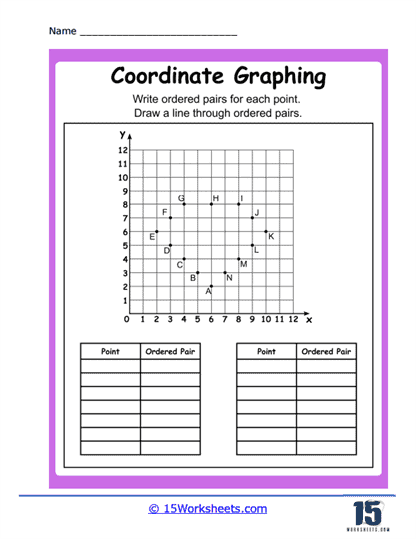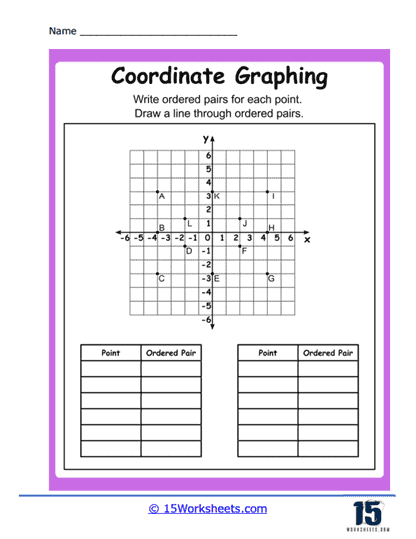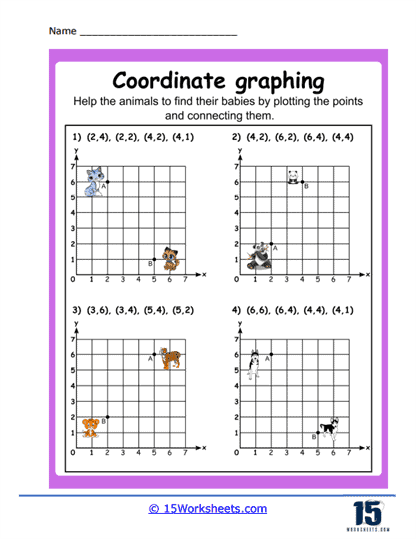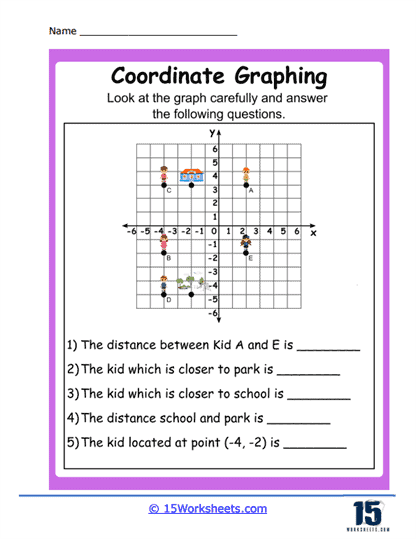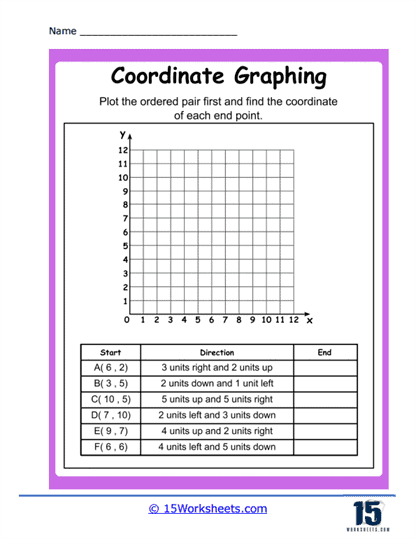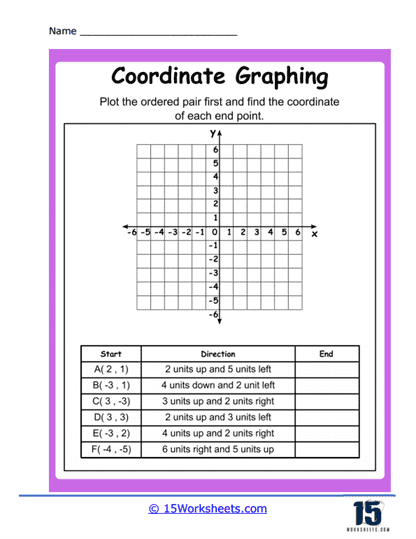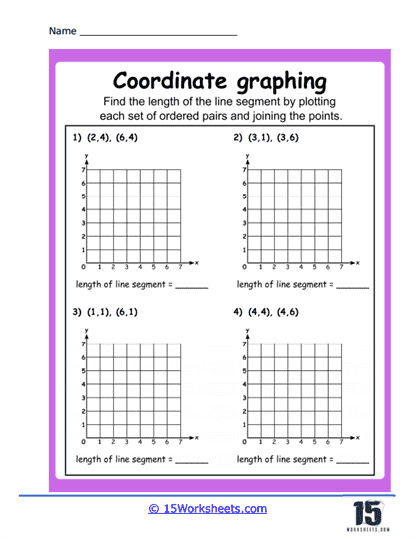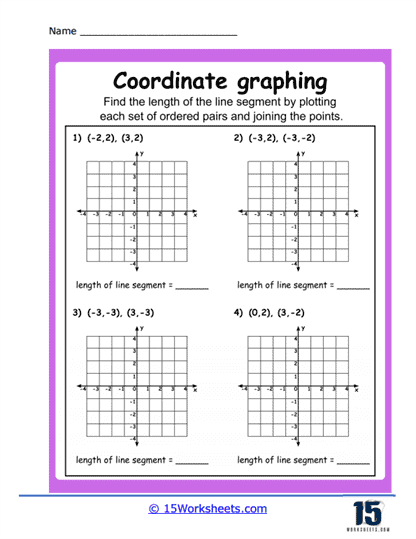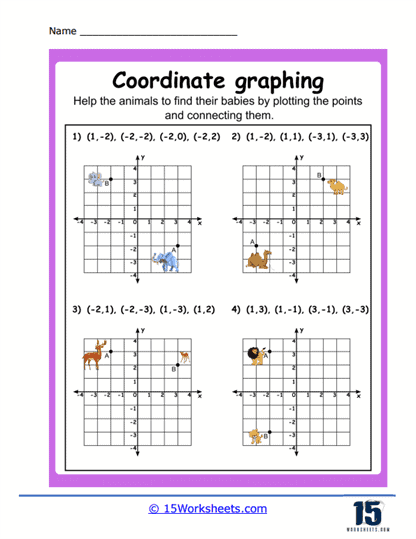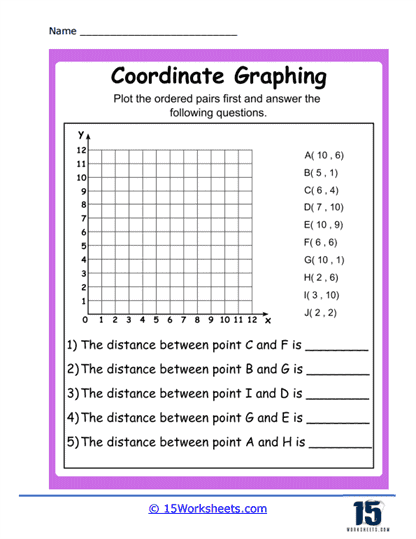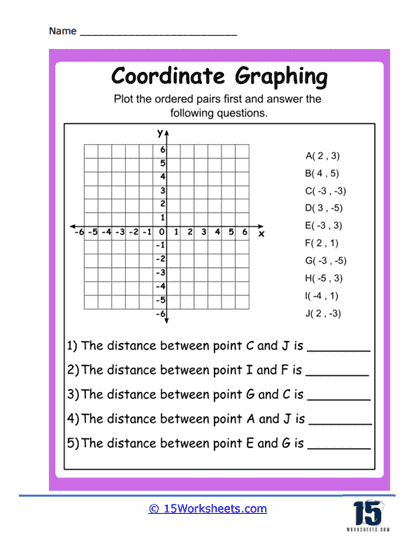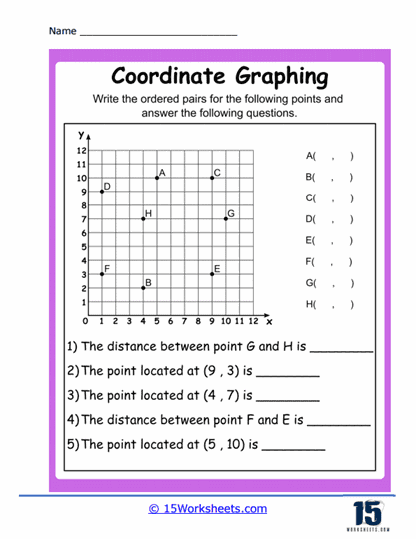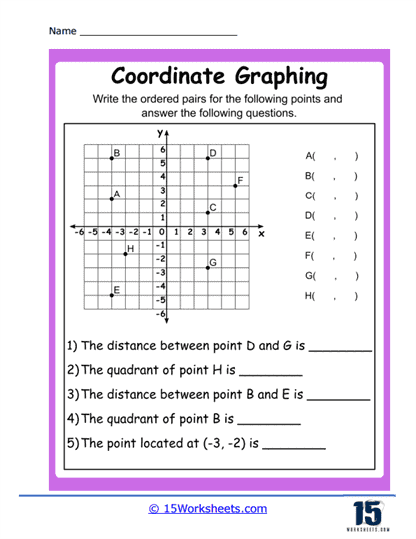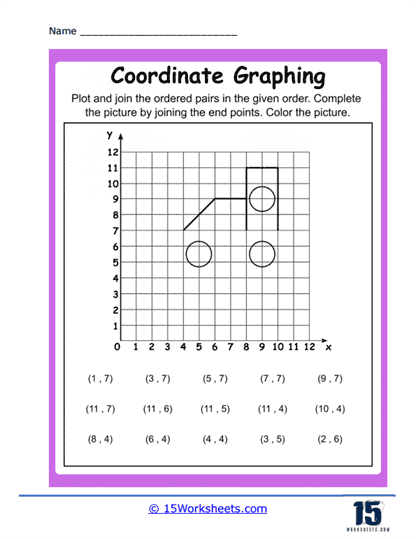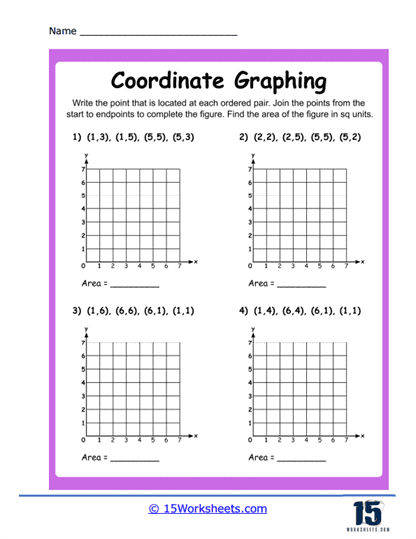Coordinate Plane Worksheets
About These 15 Worksheets
A coordinate plane enables us to depict different points and visualize various shapes, lines, and curves. In essence, the coordinate plane is a two-dimensional plane divided into four quadrants by a horizontal line, known as the x-axis, and a vertical line, the y-axis. The point where these two lines intersect is called the origin, marked as point (0,0). The location of a point in the plane is determined by two numbers, or coordinates, typically written as (x,y).
Let’s imagine you’re playing a game of Battleship, and you need to call out your opponent’s ship’s location. You would give two coordinates, like A5 or D3, where the letter represents the horizontal position and the number represents the vertical position. The coordinate plane works on the same principle, except we use numbers instead of letters and numbers.
These worksheets are filled with various exercises, each designed to help students understand and apply the principles of the coordinate plane better. Let’s explore the different types of exercises you might see on these worksheets.
1. Plotting Points
The first exercise you will encounter on a coordinate plane worksheet involves plotting points. Here, you are given a series of coordinates, such as (2,3), (-5,1), or (0, -4), and your task is to plot these points on the coordinate plane. This exercise helps you understand how the position of a point is determined by its x and y coordinates.
2. Drawing Shapes
In this type of exercise, you are given a series of coordinates, and when you plot and connect these points in the order given, you end up drawing a shape. This exercise illustrates how the coordinate plane can represent more complex figures. It helps you understand that a shape on a coordinate plane is simply a collection of points connected in a particular order.
3. Interpreting Graphs
You might also encounter exercises where you have to interpret graphs that are already plotted on the coordinate plane. These could be simple line graphs, bar graphs, or scatter plots. By interpreting these graphs, you learn to read and understand visual data, which is a critical skill in mathematics and other fields.
4. Creating Graphs
Another common exercise on Coordinate Plane Worksheets requires you to create a graph given specific information. For example, you might be given a table of values and asked to plot them on the plane. Or you could be given a relationship between two variables, like “y equals two times x,” and asked to graph this relationship on the plane. This exercise allows you to apply your understanding of the coordinate plane to display information visually.
5. Problem Solving with Coordinates
Some exercises may involve problem-solving or word problems that require you to use the coordinate plane. For example, you might be asked to find the distance between two points or to determine what point lies in the middle of two given points. These exercises help you apply the principles of the coordinate plane to solve real-world problems.
Working with these worksheets allows you to translate abstract mathematical concepts into concrete visual representations. This skill is not only essential in mathematics but is also relevant in many other fields like physics, computer science, engineering, and even art.
These worksheets also help you to interpret data visually. In today’s data-driven world, being able to read and interpret graphs is a crucial skill. Graphs enable us to spot trends, make predictions, and draw conclusions from complex data sets, so practicing with Coordinate Plane Worksheets provides a strong foundation for these important skills.
The problems that require you to apply your knowledge of coordinates in a problem-solving context. This helps you develop your problem-solving skills, which are vital in mathematics and beyond.
What is the Coordinate Plane?
A coordinate plane, also referred to as a Cartesian plane, is a fundamental concept in two-dimensional geometry. Named after the French mathematician René Descartes, the coordinate plane is used for plotting points, lines, and curves to represent and analyze various forms of data and mathematical functions.
The coordinate plane is essentially a two-dimensional surface that is split into four sections, called quadrants, by a horizontal line (the x-axis) and a vertical line (the y-axis). These two axes intersect at a point called the origin, which is the center of the plane and is represented by the coordinates (0,0).
Each point in the plane is identified by an ordered pair of numbers (x,y), called coordinates. The first number, or x-coordinate, signifies the horizontal distance from the origin, and the second number, or y-coordinate, represents the vertical distance from the origin. A point to the right of the origin has a positive x-coordinate, while a point to the left has a negative x-coordinate. Similarly, a point above the origin has a positive y-coordinate, and a point below it has a negative y-coordinate.
How Do Coordinate Planes Help You Solve Problems?
1. Graphing Equations – One of the primary uses of the coordinate plane is graphing equations. For example, if you have a linear equation like y=2x+3, you can plot it on the coordinate plane to visualize the line it represents. By graphing equations, you can better understand their behavior and solutions.
2. Identifying Relationships – By plotting points on a coordinate plane, you can often identify relationships between variables. If you graph a set of data and the points form a straight line, for example, it suggests a linear relationship between your variables.
3. Analyzing and Interpreting Data – Scatter plots, bar graphs, and line graphs plotted on a coordinate plane can provide insights into trends, patterns, and correlations in data sets. They can help us make predictions, identify outliers, or determine the rate of change.
4. Solving Geometry Problems – Coordinate geometry, which uses the principles of the coordinate plane, is a powerful tool to solve complex geometry problems, such as finding the distance between two points, determining the midpoint of a line segment, or proving geometric theorems.
The Benefits of Coordinate Planes
1. In Geography and Navigation – The concepts of the coordinate plane are the basis for geographic coordinate systems used in navigation and cartography. Latitude and longitude are similar to x and y coordinates, which pinpoint locations on Earth’s surface.
2. In Design and Architecture – Architects and designers use the principles of the coordinate plane to create 2D blueprints and models.
3. In Physics and Engineering – The principles of the coordinate plane help engineers and physicists to model and solve problems involving forces, motion, fields, and waves.
4. In Computer Science – The screen of your computer or smartphone is essentially a coordinate plane, with each pixel represented by a set of coordinates. Programmers use these principles for graphics, animations, and game design.
5. In Data Analysis and Statistics – Analysts use the coordinate plane to visualize data and find trends, outliers, and patterns, which are essential in making business or scientific decisions.

